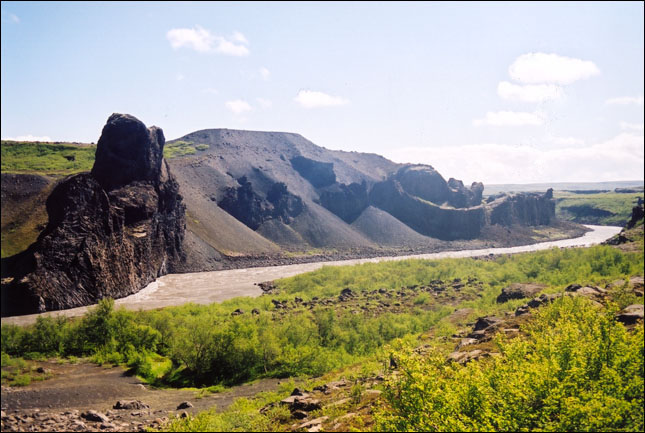Iceland: Day 12 - Jökulsá Canyon
July 6, 2004
Jökulsárgljúfur (Jökulsá Canyon), after which the park is named, is the largest and most rugges canyon system in Iceland: 25 km long, 0.5 km wide and often more than 100 m deep. The glacial river Jökulsá is the second longest river in Iceland (206 km) and comes from the glacier Vatnajökull, Iceland's largest icecap.
You can do a several day hike through the park but we decided to explore the canyon by doing the shorter hike at Hljóðaklettar ("Echo Rocks"), an area where the oddly shaped rock formations distort the noise of the river, making is seem like the river flows through the rock itself. Hljóðaklettar are cones of volcanic craters that were left behind after the Jökulsá washed away any loose material. These rock pillars are made of small structured columnar basalt. Hexagon shapes formed when hot lava cooled down slowly. Successive lava flows here have resulted in layers of basalt being stacked.
One of the formations is called Tröllið - the troll rock. Legend has it that a troll saw a local shepherd boy eating some bread, but thought that the boy was eating a stone. Wanting to outdo him, the troll popped a rock into his mouth. It was so large it stuck there, and just as the sun rose, he turned to stone. If you look carefully you might be able to make out the shape of the rock, still stuck in his mouth.
Beyond Tröllið, the formations show "honeycomb" weathering where over time some of the basalt has worn away leaving behind a honeycomb pattern on the rock surface. Different theories exist on how these holes are made. Some believe that ice and wind are responsible while others think that salt crystals brought in from ancient seas also had a a part to play. When the ice melts each spring, lumps of basalt can be broken away to expose fresh rock surfaces.
Further along the path we descended into the natural amphitheatre of Kirkjan, the church. In the past, while the area was still grazed, sheep sheltered in the caves here during bad weather.
We extended our hike by doing the loop to Rauðhólar, the Red Mountain which is actually an old volcano that caused some of the lava flows in the area that created the basalt columns in the canyon. From Rauðhólar we got some great views of the Jökulsá canyon.
We also visited the two petrified trolls Karl (the Old Man) and Kerling (the Old Woman). This used to be one of the best places to cross the dangerous Jökulsá before a bridge was built in 1905. Across the river we saw Tröllahellir, the largest cave in the canyon which we figured to be the home of Karl and Kerling.

The Jökulsá winds along the way carving out more of the canyon.
The layers of basalt columns were formed by cooling lava flows.
Rubby checking out the layers of basalt columns up close.
A good example of honeycomb weathering.
The natural amphitheatre of Kirkjan, the church.
Rubby inside Kirkjan. At the far end was a rock that all the kids would throw sand on and then rub... we never did find out the significance but we followed suit just to be safe.
Interesting geology along the hike up Rauðhólar.
The hike up to Rauðhólar, an extinct volcano.
A great example of a pillar of basalt columns and the cliff across the canyon.
Rubby plays in one of the caves.
Karl and Kerling, the petrified trolls, standing in front of their troll house.
A little bird chirps hello.
A great view of Jökulsá Canyon, Hljóðaklettar, and Rauðhólar.
[ Iceland Vacation Home Page ]